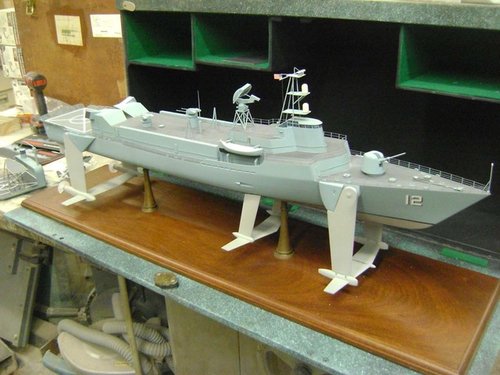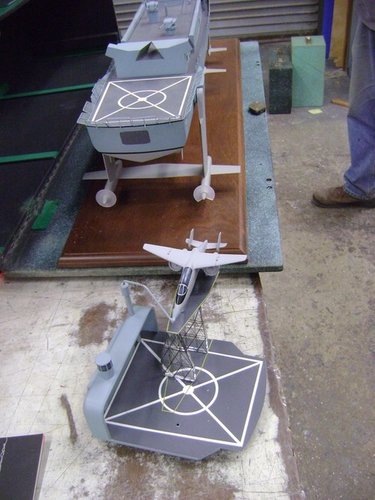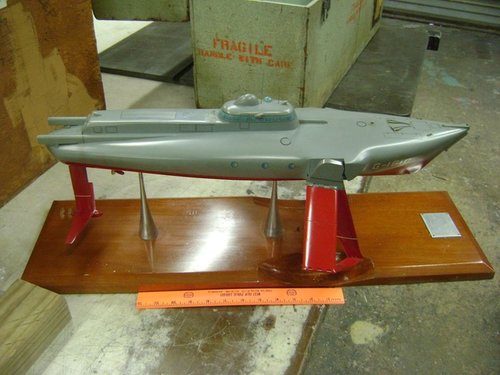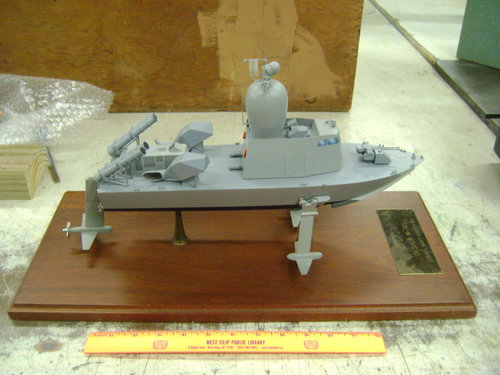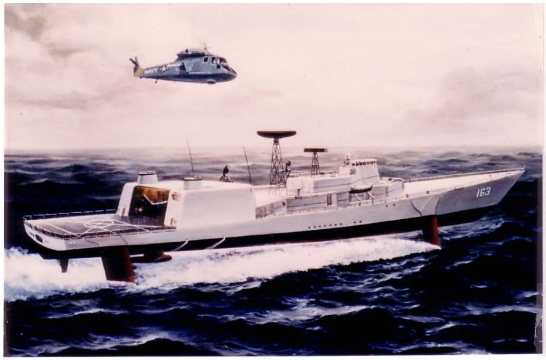You are using an out of date browser. It may not display this or other websites correctly.
You should upgrade or use an alternative browser.
You should upgrade or use an alternative browser.
Grumman hydrofoil warship (HYD-2)
- Thread starter allysonca
- Start date
- Joined
- 11 March 2011
- Messages
- 307
- Reaction score
- 1,193
All are Grumman......Interesting indeed. First set are IIRC a Grumman destroyer escort concept. The second one looks German.
But neither are SCS.
- Joined
- 16 April 2008
- Messages
- 9,601
- Reaction score
- 14,474
All are Grumman......Interesting indeed. First set are IIRC a Grumman destroyer escort concept. The second one looks German.
But neither are SCS.
And not related to SCS...
Ok, so the first on is HYD-2 or a close relative. It probably deserves its own thread.
- Joined
- 16 April 2008
- Messages
- 9,601
- Reaction score
- 14,474
Ok, this one is familiar. The Grumman M161 hydrofoil was built as Shimrit (built by Grumman in the US) and Shlomit (built in Israel). They were developed versions of the USN's experimental Flagstaff. They were seen as a.potential successor to the Saar missile boats but proved too expensive to operate and had only a short lifespan.ANOTHER GRUMMAN BOATView attachment 616535
Or this.... just because it is so cool looking.........
Many, many more photos are called for.
A bit of history:
Boeing also did a little work:
Boeing also did a little work:
Last edited by a moderator:
- Joined
- 6 September 2006
- Messages
- 4,833
- Reaction score
- 9,442
Ok, this one is familiar. The Grumman M161 hydrofoil was built as Shimrit (built by Grumman in the US) and Shlomit (built in Israel). They were developed versions of the USN's experimental Flagstaff. They were seen as a.potential successor to the Saar missile boats but proved too expensive to operate and had only a short lifespan.
Of the 12 planned, only 3 were built.
Around 1988-89 there were rumours of a new joint US/Israeli hydrofoil, perhaps further developed from the 'Flagstaff 2' but I've never seen any details. I assume if the reports were true that it would too be a Grumman design,
- Joined
- 16 April 2008
- Messages
- 9,601
- Reaction score
- 14,474
Ok, this one is familiar. The Grumman M161 hydrofoil was built as Shimrit (built by Grumman in the US) and Shlomit (built in Israel). They were developed versions of the USN's experimental Flagstaff. They were seen as a.potential successor to the Saar missile boats but proved too expensive to operate and had only a short lifespan.
Of the 12 planned, only 3 were built.
Around 1988-89 there were rumours of a new joint US/Israeli hydrofoil, perhaps further developed from the 'Flagstaff 2' but I've never seen any details. I assume if the reports were true that it would too be a Grumman design,
Combat Fleets 1993 says 15 were initially planned, reduced to three, but actually lists only two ships (Shimrit and Livnit, vice Shlomit) and states that a reported third unit (Snaprit) never actually existed. It also notes that the first two were built in parallel in the US and Israel, with many delays. Although the US unit was launched about two years earlier (1981), both entered service sometime in 1983. Grumman subcontracted the shipbuilding to Lantana Shipbuilding, Florida, while the Israeli unit was built at Israel Shipyard in Haifa. Performance never lived up to the advertised 52 knots; 47 was the maximum in trials and 42-45 was more typical in operation. Interestingly, the big pineapple dome is apparently not for radar, but for some sort of intercept (ESM/ELINT) array.
Last edited:
- Joined
- 6 September 2006
- Messages
- 4,833
- Reaction score
- 9,442
Jane's says 15 were initially planned, reduced to three. Combat Fleets 1993 actually lists only two ships (Shimrit and Livnit, vice Shlomit) and states that a reported third unit (Snaprit) never actually existed. It also notes that the first two were built in parallel in the US and Israel, with many delays. Although the US unit was launched about two years earlier (1981), both entered service sometime in 1983. Grumman subcontracted the shipbuilding to Lantana Shipbuilding, Florida, while the Israeli unit was built at Israel Shipyard in Haifa. Performance never lived up to the advertised 52 knots; 47 was the maximum in trials and 42-45 was more typical in operation. Interestingly, the big pineapple dome is apparently not for radar, but for some sort of intercept (ESM/ELINT) array.
My 1989-90 Janes says 12, so it looks like the programme had been trimmed before the programme got into the construction phase. Yes, I'm not sure what the ESM array was, certainly looks big.
- Joined
- 16 April 2008
- Messages
- 9,601
- Reaction score
- 14,474
All are Grumman......Interesting indeed. First set are IIRC a Grumman destroyer escort concept. The second one looks German.
But neither are SCS.
And not related to SCS...
Ok, so the first on is HYD-2 or a close relative. It probably deserves its own thread.
Somewhere I have a Jane's Surface Skimmers with a complete writeup, but in the interim, I found a good description in this article:
https://www.foils.org/wp-content/up...t-and-Applications-Meyer-Wilkins-Jun-92-1.pdf
HYD-2 was a late 1970s design from Grumman. As designed, it was to be 2400 tons, 365 ft length overall, 116 ft beam over the aft foils. The foils described here are just two "inverted pi" foils (two struts connected to a single foil), with props in pods at the base of each strut. That's different from the arrangement in the model above, which has a third (fixed?) foil midships.
Propulsion consisted of two P&W FT-9 turbines for foilborn propulsion, one GE LM500 turbine for hullborne propulsion, and three Lycoming TF-35s for electrical generation. Speed was supposed to be 53.1 knots on foils in calm water, down to 51 knots in Sea State 6. Hullborne speed on one FT-9 was 26 knots, on the LM500 it was 15 knots.
Armament seems to have varied for mission, but it would have included some mix of "advanced" vertical-launched SAMs, Harpoon, lightweight torpedoes, Mk 48 heavyweight torpedoes. The Mk 48s are a bit late for the era; the 1960s Knox class design had provision for heavyweight torpedos, though they were never fitted. You can see what I think are Mk 48 tubes just below the bridge. Sesnors included unspecified radar and towed array for ASW (good luck towing an array at speed, though, or streaming and reeling it fast enough for sprint tactics. A fast-reeling variable-depth sonar would make more sense for a ship like this.) The helo was supposed to be LAMPS III.
I notice that the details of the model don't quite match the HYD-2 artist's conception. Aside from the foils, the sketch seems to show an actual hangar, while the model only shows a pad. The little partial model with a Grumman VTOL is closer to the drawing and might show a hangar door.
Edit: Replaced the previous version of this picture with a much improved copy.
Attachments
Last edited:
- Joined
- 16 April 2008
- Messages
- 9,601
- Reaction score
- 14,474
Jane's says 15 were initially planned, reduced to three. Combat Fleets 1993 actually lists only two ships (Shimrit and Livnit, vice Shlomit) and states that a reported third unit (Snaprit) never actually existed. It also notes that the first two were built in parallel in the US and Israel, with many delays. Although the US unit was launched about two years earlier (1981), both entered service sometime in 1983. Grumman subcontracted the shipbuilding to Lantana Shipbuilding, Florida, while the Israeli unit was built at Israel Shipyard in Haifa. Performance never lived up to the advertised 52 knots; 47 was the maximum in trials and 42-45 was more typical in operation. Interestingly, the big pineapple dome is apparently not for radar, but for some sort of intercept (ESM/ELINT) array.
My 1989-90 Janes says 12, so it looks like the programme had been trimmed before the programme got into the construction phase. Yes, I'm not sure what the ESM array was, certainly looks big.
My mistake. It was actually CF that said 15. The program was almost certainly in constant flux.
- Joined
- 13 June 2007
- Messages
- 2,173
- Reaction score
- 3,087
Very cool! What does the plate say on the base?Or this.... just because it is so cool looking.........View attachment 616507
Enjoy the Day! Mark
- Joined
- 16 April 2008
- Messages
- 9,601
- Reaction score
- 14,474
Still not finding much more detail. It appears the Grumman project number for this was M163 (the Flagstaff Mk IIs for Israel were M161). That matches the hull number on the drawing I posted, but not on the model.
There are a bunch of technical reports referenced online but they mostly haven't been uploaded anywhere. This one looks especially helpful and is available on the AIAA website, but $25 is a bit steep. (Anyone have an institutional login?):
Side note: It looks like the HYD-# was a Navy numbering scheme. A Boeing hydrofoil study from the same Advanced Naval Vehicles Concept Evaluation program was designated HYD-7.
There are a bunch of technical reports referenced online but they mostly haven't been uploaded anywhere. This one looks especially helpful and is available on the AIAA website, but $25 is a bit steep. (Anyone have an institutional login?):
- "Grumman Design M163-A 2400 Metric Ton Air Capable Hydrofoil APR 78 Ship", by C.G. Pieroth, Grumman Aerospace Corp., AIAA/SNAME Advanced Marine Vehicles Conf., San Diego, Calif., April 17-19, 1978.
Side note: It looks like the HYD-# was a Navy numbering scheme. A Boeing hydrofoil study from the same Advanced Naval Vehicles Concept Evaluation program was designated HYD-7.
Last edited:
- Joined
- 16 April 2008
- Messages
- 9,601
- Reaction score
- 14,474
How about this kids:View attachment 616506
Took a minute to spot this. It's a Grumman G-674 Nutcracker. The rig seems to be incomplete; there should be an articulated crane arm that holds that landing platform and rotates the aircraft into the hangar.
Here's the thread on this aircraft, complete with a bunch of photos showing the handing rig on an FF-1052 frigate.
- Joined
- 9 October 2009
- Messages
- 21,944
- Reaction score
- 13,577
Saw the Nutcracker as well but didn't think to comment on it. D'oh!
- Joined
- 21 May 2006
- Messages
- 3,002
- Reaction score
- 2,270
When I first looked at this beautiful model, one of the first things that tool my eye was the two smaller turret systems on roof (mid-ship?)
Looked like 30-35mm AAA type, so did some net surfing in an attempt to confirm/ascertain type..........
I came to the conclusion that they're most likely Oerlikon GDM-C 35mm/90's???
Also found this snippet of interesting info in relation to the Oerlikon GDM-C 35mm/90 mount:
"....A US Navy Foreign Ordnance Review Team concluded about 1971 that this version was better suited to US requirements, but none were purchased"
(Source: http://www.navweaps.com/Weapons/WNIT_35mm-90_KDC.php)
Regards
Pioneer
Looked like 30-35mm AAA type, so did some net surfing in an attempt to confirm/ascertain type..........
I came to the conclusion that they're most likely Oerlikon GDM-C 35mm/90's???
Also found this snippet of interesting info in relation to the Oerlikon GDM-C 35mm/90 mount:
"....A US Navy Foreign Ordnance Review Team concluded about 1971 that this version was better suited to US requirements, but none were purchased"
(Source: http://www.navweaps.com/Weapons/WNIT_35mm-90_KDC.php)
Regards
Pioneer
Attachments
- Joined
- 16 April 2008
- Messages
- 9,601
- Reaction score
- 14,474
When I first looked at this beautiful model, one of the first things that tool my eye was the two smaller turret systems on roof (mid-ship?)
Looked like 30-35mm AAA type, so did some net surfing in an attempt to confirm/ascertain type..........
I came to the conclusion that they're most likely Oerlikon GDM-C 35mm/90's???
Also found this snippet of interesting info in relation to the Oerlikon GDM-C 35mm/90 mount:
"....A US Navy Foreign Ordnance Review Team concluded about 1971 that this version was better suited to US requirements, but none were purchased"
(Source: http://www.navweaps.com/Weapons/WNIT_35mm-90_KDC.php)
Regards
Pioneer
It's certainly possible. That was the original gun on the PF-109 design before the FFG-7 switched to the OTO Melara 76mm.
But it could also be the Emerlec EX-74 twin 30mm gun, which was developed around the same time and shows up in some other designs like the CPIC. They look really similar at the level of detail in the model. I'd lean toward the Emerlec because it's significantly smaller than the main gun, which seems to be a 76mm.
USA 30 mm Emerlec-30 - NavWeaps
- Joined
- 16 April 2008
- Messages
- 9,601
- Reaction score
- 14,474
The International Hydrofoil Society came through again! This is a report on Grumman's M165, a 70-knot hydrofoil using supercavitating foils and propellers.
It's clearly related to the M163 HYD-2 (also referred to as the Hydrofoil Ocean Combatant), but is smaller (~1300 tons) and has significantly more installed power -- three FT-9s instead of two. So a 50% increase in power to drive roughly half the displacement to 20% higher speed. And it sounds like there were doubts about the viability of supercavitating foils in "random" sea states. The report says the foils will inevitably "ventilate to atmosphere," which I interpret to mean that the supercavitating bubble will collapse and the foils will slam into liquid water at high speed, creating a very rough ride.
The drawings provide a sense of the arrangements (including armament). It also confirms what I suspected -- the twin small-caliber mounts aft are 30mm (and thus Emerlec EX-74s). The remaining armament is one 76mm OTO Melara gun forward, two banks of 11 vertical launch tubes for Standard MR along the sides of the deckhouse, and two forward-firing heavyweight torpedo tubes. The torpedoes are stowed in a novel configuration, stacked one on top of each other along the sides of the deckhouse above the torpedo rooms. The plan drawing says 5 each port and starboard, but the cross-section drawing shows the outlines of 7 weapons (possibly plus one in the torpedo tube), so the total capacity is anywhere between 10 and 16 heavyweight torpedoes.
Above-water sensors include a large 2-D air search radar (either SPS-49 or -59) and a couple of smaller radars in domes over the bridge. There would also be an SPS-55 surface search set (not shown in the drawings), and a fire control system derived from AWG-9 using two small antennas (one for volume search and one for illumination and fire control). Electronic warfare systems include the APR-59 ESM (from the E-2C) and ALQ-99 ECM (from the EA-6B). It's interesting that Grumman was leaning heavily on its aircraft electronics experience. A company with more shipbuilding expertise might have opted for different systems here.
The primary below-water sensor is the APRAPS (Active-Passive Reliable Acoustic Path Sonar) -- basically a large helicopter-type dipping sonar deployed below the ship on a cable. There is also room for a notional variable-depth sonar or towed array.
Edit: I've been comparing the model with this design and with the illustration of HYD-2, and I suspect that the model is closer in size to the M165 (~1300 tons) than the M163/HYD-2 (2400 tons).
It's clearly related to the M163 HYD-2 (also referred to as the Hydrofoil Ocean Combatant), but is smaller (~1300 tons) and has significantly more installed power -- three FT-9s instead of two. So a 50% increase in power to drive roughly half the displacement to 20% higher speed. And it sounds like there were doubts about the viability of supercavitating foils in "random" sea states. The report says the foils will inevitably "ventilate to atmosphere," which I interpret to mean that the supercavitating bubble will collapse and the foils will slam into liquid water at high speed, creating a very rough ride.
The drawings provide a sense of the arrangements (including armament). It also confirms what I suspected -- the twin small-caliber mounts aft are 30mm (and thus Emerlec EX-74s). The remaining armament is one 76mm OTO Melara gun forward, two banks of 11 vertical launch tubes for Standard MR along the sides of the deckhouse, and two forward-firing heavyweight torpedo tubes. The torpedoes are stowed in a novel configuration, stacked one on top of each other along the sides of the deckhouse above the torpedo rooms. The plan drawing says 5 each port and starboard, but the cross-section drawing shows the outlines of 7 weapons (possibly plus one in the torpedo tube), so the total capacity is anywhere between 10 and 16 heavyweight torpedoes.
Above-water sensors include a large 2-D air search radar (either SPS-49 or -59) and a couple of smaller radars in domes over the bridge. There would also be an SPS-55 surface search set (not shown in the drawings), and a fire control system derived from AWG-9 using two small antennas (one for volume search and one for illumination and fire control). Electronic warfare systems include the APR-59 ESM (from the E-2C) and ALQ-99 ECM (from the EA-6B). It's interesting that Grumman was leaning heavily on its aircraft electronics experience. A company with more shipbuilding expertise might have opted for different systems here.
The primary below-water sensor is the APRAPS (Active-Passive Reliable Acoustic Path Sonar) -- basically a large helicopter-type dipping sonar deployed below the ship on a cable. There is also room for a notional variable-depth sonar or towed array.
Edit: I've been comparing the model with this design and with the illustration of HYD-2, and I suspect that the model is closer in size to the M165 (~1300 tons) than the M163/HYD-2 (2400 tons).
Attachments
Last edited:
- Joined
- 16 April 2008
- Messages
- 9,601
- Reaction score
- 14,474
There are a bunch of technical reports referenced online but they mostly haven't been uploaded anywhere. This one looks especially helpful and is available on the AIAA website, but $25 is a bit steep. (Anyone have an institutional login?):
- "Grumman Design M163-A 2400 Metric Ton Air Capable Hydrofoil APR 78 Ship", by C.G. Pieroth, Grumman Aerospace Corp., AIAA/SNAME Advanced Marine Vehicles Conf., San Diego, Calif., April 17-19, 1978.
I went ahead and grabbed this report after all. Turns out it gives some interesting insight not just into the HYD-2 design but also one school of thinking about USN sensors and weapons for the early 1990s as imagined from the 1970s. Unfortunately, the image quality is terrible. I’ll include two drawings that are easy to interpret, but the text is largely illegible.
First, the ship itself. As already known, the Grumman M163 HYD-2 was an ocean-going hydrofoil escort, envisaged as a 1990s successor to the PF-109/FFG-7 design. The basic design is fairly familiar, two inverted pi foils, with the aft foil holding a pair of podded propellers and the forward foil having steerable struts. Another pair of pods contained the hullborne propulsion propellers and gearing. Construction is an aluminum hull with HY130 steel hydrofoils. Interestingly, the designers appear to have anticipated keeping the foils down whenever the water was deep enough even when not foilborne; they didn’t even bother to calculate most of the performance specs hullborne with foils up.
Propulsion machinery includes two Pratt & Whitney FT-9 turbines, which were then in development and put out about twice the power of the contemporary versions of the LM2500. Backup cruise power came from a single GE LM500, with electrical power from 3 Lycoming TF35 turbines. Everything was mechanically linked through gearboxes (which was one of the major risk areas, since the gearboxes had to handle lots of power at high RPMs and in various combinations).
Top foilborne speed as around 51 knots (reducing only slightly with increasing sea state), max hullborne speed was around 26 knots using one FT-9 or 15 knots using the LM500. Takeoff speed was around 25 knots. Range varied from 2800 nm at 45 knots (foilborne) to 3250 nm at 20 knots (hullborne using an FT-9) and 5900 nm at 14 knots (hullborne on the LM500).
Armament is interesting, and amazingly heavy for a ship of this size. They envisaged 72 “universal” VLS cells arranged two-deep along the outside of the deckhouse on both sides. These cells could carry the ASAR (MR) SAM (or presumably Standard MR), Harpoon, or ASW Standoff weapons. Nominal load was 40 SAM, 16 Harpoon, and 16 ASW weapons. In addition, there were 24 Advanced Self-Defense Missiles in vertical launchers forward of the bridge. (Note: The dark spots on the hull are plenum vents for rocket exhaust from the various vertical launchers). ASAR I’ve described in another thread. ASDM is undefined, but I think it was the notional successor to NATO Sea Sparrow. The ASW Standoff weapon was possibly Sea Lance/ASW SOW.
There were also four Mk 48 heavyweight torpedoes in canister launchers on the main deck forward of the bridge. Again, heavyweight surface-launched torpedoes had been popular a few years earlier but were disappearing again by this point. There is a magazine with 36 Advanced Lightweight Torpedoes (what became Mk 50), but no provision for launching these “over the side” so they were strictly helicopter weapons.
Notably, there is no mention of guns at all, though I’m sure I’ve seen drawing of this hull with a 5-inch gun forward.
Radars and fire control include an “advanced dual-band 2-d radar” (looks like something similar to SPS-49 but lighter and dual-band?), an “Aegis-derivative” rotating phased array (doesn’t look much like a SPY array, being wide and fairly short), one Mk 74 FCS radar, an “advanced lightweight Track-While Scan” radar (possible derived from AWG-9?), and one APS-116 surface search radar (originally an airborne periscope detection radar). There is also an unspecified anti-ship missile defense EW system.
Sonar was quite different from contemporary ships. No fixed hull sonar at all, just the ARAPS “dipping” sonar deployed on a cable below the hull, a towed array, six “deployable linear arrays,” and a number of ERAPS buoys (10 over-the-side and 26 rocket-propelled, with vertical launchers alongside the bridge). There were also 200 Type A sonobuoys for helicopters plus 10 “dropline” sonobuoys (not sure what these are).
The aviation element included two LAMPS III helos and twelve “standard ship-launched RPVs,” probably of the same type described for the smaller M165 hydrofoil. Notably, I don’t see space for the RAST hauldown system. Perhaps they thought the foils would make the ship stable enough at high sea states that RAST would not be required? I think a Harpoon-style deck lock would be needed, at minimum.
Attachments
A reference to HYD-2 also pops up in Hydrofoil Development and Applications by Myer & Wilkins, 1992:
Quite apart from that it's also an extremely interesting read because it outlines several other military developments, including a proposed 22 ft. stretch of the Pegasus class.
Quite apart from that it's also an extremely interesting read because it outlines several other military developments, including a proposed 22 ft. stretch of the Pegasus class.
History of Foiling.

 www.yachtingworld.com
www.yachtingworld.com

Foiling: the history of the hydrofoiler - Yachting World
Foiling has taken the watersports world by storm in recent years, but the history of the hydrofoiler goes back further than you might think
- Joined
- 16 April 2008
- Messages
- 9,601
- Reaction score
- 14,474
History of Foiling.

Foiling: the history of the hydrofoiler - Yachting World
Foiling has taken the watersports world by storm in recent years, but the history of the hydrofoiler goes back further than you might thinkwww.yachtingworld.com
Not sure how hydrofoil sailboats are relevant to the thread, but OK?
Sirpad
I really should change my personal text
- Joined
- 17 August 2012
- Messages
- 10
- Reaction score
- 39
Found this one earlier, lesser quality but at least coloredAll are Grumman......Interesting indeed. First set are IIRC a Grumman destroyer escort concept. The second one looks German.
But neither are SCS.
And not related to SCS...
Ok, so the first on is HYD-2 or a close relative. It probably deserves its own thread.
Somewhere I have a Jane's Surface Skimmers with a complete writeup, but in the interim, I found a good description in this article:
https://www.foils.org/wp-content/up...t-and-Applications-Meyer-Wilkins-Jun-92-1.pdf
HYD-2 was a late 1970s design from Grumman. As designed, it was to be 2400 tons, 365 ft length overall, 116 ft beam over the aft foils. The foils described here are just two "inverted pi" foils (two struts connected to a single foil), with props in pods at the base of each strut. That's different from the arrangement in the model above, which has a third (fixed?) foil midships.
Propulsion consisted of two P&W FT-9 turbines for foilborn propulsion, one GE LM500 turbine for hullborne propulsion, and three Lycoming TF-35s for electrical generation. Speed was supposed to be 53.1 knots on foils in calm water, down to 51 knots in Sea State 6. Hullborne speed on one FT-9 was 26 knots, on the LM500 it was 15 knots.
Armament seems to have varied for mission, but it would have included some mix of "advanced" vertical-launched SAMs, Harpoon, lightweight torpedoes, Mk 48 heavyweight torpedoes. The Mk 48s are a bit late for the era; the 1960s Knox class design had provision for heavyweight torpedos, though they were never fitted. You can see what I think are Mk 48 tubes just below the bridge. Sesnors included unspecified radar and towed array for ASW (good luck towing an array at speed, though, or streaming and reeling it fast enough for sprint tactics. A fast-reeling variable-depth sonar would make more sense for a ship like this.) The helo was supposed to be LAMPS III.
I notice that the details of the model don't quite match the HYD-2 artist's conception. Aside from the foils, the sketch seems to show an actual hangar, while the model only shows a pad. The little partial model with a Grumman VTOL is closer to the drawing and might show a hangar door.
Edit: Replaced the previous version of this picture with a much improved copy.
Attachments
ILikeTanks
ACCESS: Confidential
- Joined
- 16 January 2023
- Messages
- 70
- Reaction score
- 40
This ship look surprisingly similar to the De Havilland hydrofoil prototype.
- Joined
- 16 April 2008
- Messages
- 9,601
- Reaction score
- 14,474
This ship look surprisingly similar to the De Havilland hydrofoil prototype.
You mean Bras d'Or?
No real connection, as far as I know, just the need for long and narrow hulls for speed. The foils and propulsion are quite different.
Similar threads
-
-
-
Boeing Marine System - Hydrofoil Sub-Chaser 1960
- Started by Grey Havoc
- Replies: 2
-
Boeing PCH-1 "High Point" Navy Patrol Hydrofoil Missile (PHM) ships
- Started by Stargazer
- Replies: 2
-

